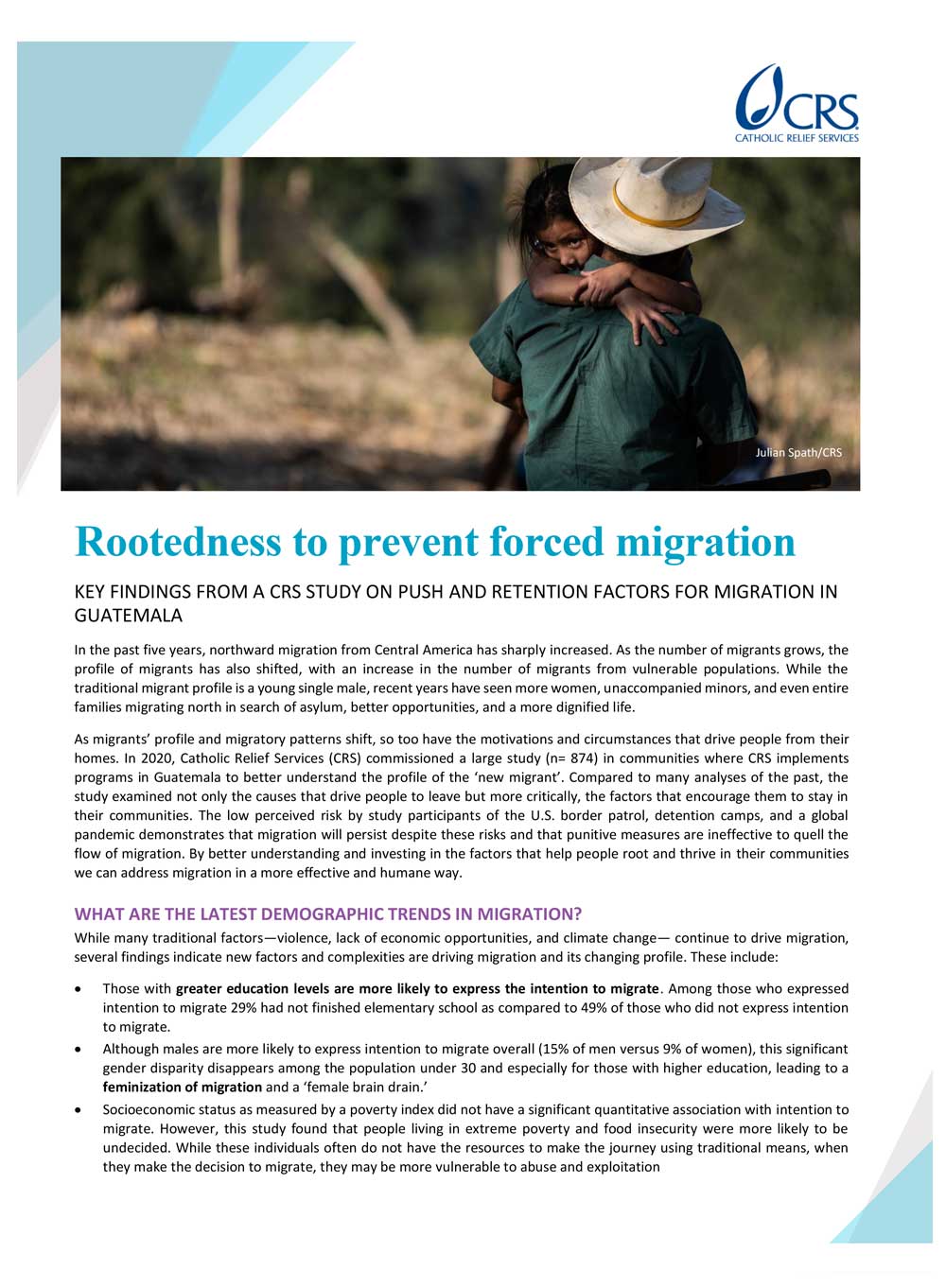

Central American Migrant Crisis: Policy Brief
Executive Summary
The crisis of migrants fleeing Central America came to a head in 2014, when an unprecedented 68,000 young people crossed the U.S.-Mexico border.1 Fleeing gang violence and drug cartels that pervaded Guatemala, El Salvador, and Honduras, these youth sought the protection due them, yet were met with political maneuvering, increased securing of borders and immigration enforcement. The additional underlying causes for flight including poverty, failed harvests due to environmental degradation and climate change, and a lack of livelihood opportunities contribute to the ongoing “push factors” for why people continue to flee.
Catholic Relief Services has worked in Latin America since the 1960s and operates under the following Catholic teachings around migration and development:
- People have the right to migrate to sustain their lives and the lives of their families.
- People have a right not to migrate; that is, to meet their needs where they are.
- A country has the right to regulate its borders and to control immigration.
- A country must regulate its borders with justice and mercy.
Policy Recommendations
Based on these Catholic principles and our experience Central American countries, CRS provides the following recommendations to the U.S. government to address the migrant crisis in Central America:
-
Concentrate on the process.
Successfully implementing the “Plan for Prosperity” will require coordination, accountability and oversight. Full engagement of the intended beneficiaries will ensure that development spending is fitting to their needs. Addressing corruption will also be important. Funding should be provided to government, international organizations and local institutions according to which institutions will spend the resources most effectively. -
Address root causes.
Funding should focus on the poor and marginalized in each country to reduce social inequality and provide broad opportunities for economic growth. Rural areas must be revitalized and incorporate conflict analysis to ensure programs are conflict sensitive. Increased investment in disaster risk reduction and climate change adaptation activities are also needed. Programs for youth education and employment must be scaled up and expanded. Education must also be improved to expand opportunities for young people. Initiatives including micro-enterprise, rural credit and micro-insurance mechanisms should also be expanded and integrated into programing.
Addressing violence is an important aspect of any funding proposal, and can be accomplished through stand-alone projects or integrated into existing or new projects. In addition, child protection systems need strengthening. -
Adequately protect and provide solutions to those seeking asylum in the U.S., and provide robust assistance to those who are repatriated.
The U.S. must urgently halt deportations of asylum-seekers, and provide more legal venues for refugees and asylum-seekers to find protection in the U.S., including through the Central American Minors program. The needs of those who are turned back home are great, and need to be prioritized and met. Money should be channeled to organizations that understand how to respond to these needs, and a strategic plan should be put in place to meet the needs of the internally displaced. -
Take an integrated and comprehensive approach.
We need to take a regional approach to the crisis—USAID should engage in regional planning, which includes learning and sharing across country programs and projects. Funding and programs need to take an integrated approach over a realistic time frame, and be implemented by national institutions or civil society depending on political will and capacity. The private sector also has an essential role in creating opportunities for youth and should be engaged in public-private partnerships.
Donors need to be more creative and expansive in understanding the problem of violence, and address the needs of former gang members and incarcerated individuals, and projects should integrate psychosocial support. Any aid package must be continuously reassessed and responsive to challenges that will undoubtedly continue.
1 Customs and Border Patrol. “Southwest Border Unaccompanied Alien Children.” Accessed September 1, 2015.


